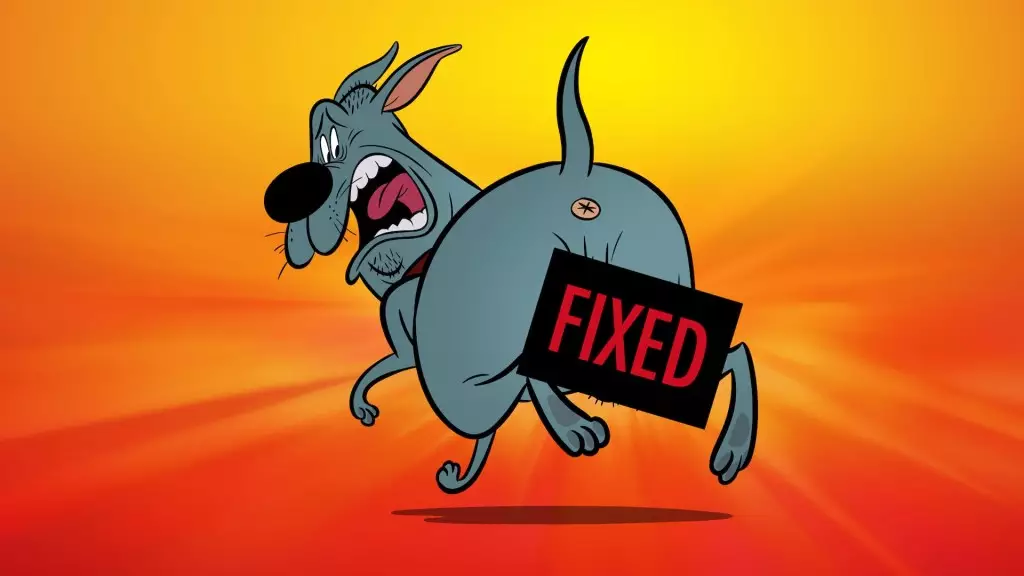In the realm of animated films, there has always been a tug-of-war between family-friendly storytelling and the raw, gritty humor that appeals to adult sensibilities. “Fixed,” recently unveiled at the Annecy International Festival of Animation, heralds a new era in adult animation that pushes the boundaries of what we expect from animated narratives. This Netflix offering, featuring a flagrant celebration of crude humor and R-rated antics, stands as a stark contrast to the light-hearted tones often cultivated in traditional animation, suggesting that the genre can be a limitless playground for unbridled creativity.
Unlike its predecessors that tread cautiously around adult themes, “Fixed” dives headfirst into the murky waters of sexuality and identity through the eyes of Bull, a dog struggling with the impending loss of his reproductive organs. The film’s audacity evokes the spirit of classics like “Sausage Party” while drawing parallels with the groundbreaking works of Ralph Bakshi. It’s clear that the creators of “Fixed,” led by director Genndy Tartakovsky, intend to make a statement about the capability of animation as a serious medium for adult content, like how Bakshi proclaimed cartoons are not just for children.
The Inevitable Controversy
However, the unfiltered nature of “Fixed” is not without its inherent risks. As parents wrestle with the increasing availability of mature content, there lies an ethical conundrum: how responsible should platforms like Netflix be in gatekeeping such content? The very notion that this film may land in the hands of unsuspecting children raises alarm bells, painting a landscape where intention and accessibility clash. The film certainly warns viewers off the bat, thrusting the audience into a world filled with sexual escapades that would make most parents recoil. Still, one can’t help but feel that the film’s creator isn’t merely pushing boundaries for shock value, but engaging in meaningful commentary about masculinity, rivalry, and the absurdity of societal norms surrounding male identity.
Bull’s obsessive fixation on his own anatomy serves as both a comedic vehicle and a biting critique of the overly machismo culture that often plagues societal narratives around masculinity. Instead of finding his fulfillment through traditional romantic arcs, Bull’s journey is riddled with encounters that are simultaneously funny and heartbreakingly relatable. In this dog-eat-dog world, we witness a complex dichotomy between comedy and poignant social critique, and therein lies the film’s triumph.
Character Dynamics: A Reflection on Society
Central to “Fixed” are its delightfully flawed characters, each one meticulously designed to reflect a spectrum of dog archetypes that cleverly mirror human traits. Bull, with his unquenchable thirst for affirmation and ultimately absurd circumstances, becomes a symbol of the existential crisis faced by many in a modern context. His flamboyant camaraderie with hounds like Rocco, Fetch, and the lovable Chihuahua, Lucky, highlight the importance of friendship as a counterbalance to the chaos of individual desires. There’s a sense of community that encapsulates the experience, albeit seasoned with doggy mischief.
The romantic subplot between Bull and the glamorous Afghan hound Honey raises the stakes beautifully, carefully threading humor through a tale of unrequited love and societal standards of beauty. In contrast, the introduction of Sterling, the narcissistic showdog, amplifies the rivalry, delivering a sharp critique of the dog-eat-dog mentality that defines competition not just in the canine world but also in human interactions.
The juxtaposition of this flamboyant and absurd character dynamic provides a stark commentary on vanity and the price one pays for superficiality. This is where Tartakovsky and co-writer Jon Vitti show exceptional insight, transforming what could have been merely juvenile humor into an exploration of relatable struggles within our contemporary society.
The Fearless Language of Animation
What propels “Fixed” into a league of its own in the realm of animated features is how unapologetically it employs language—vulgarities and all—echoing the realities of its characters’ lives. The playful yet provocative use of crude humor subverts expectations and broadens the appeal of animation in adult discourse. To watch Bull’s wild, debaucherous adventures is to witness an audacious celebration of freedom in storytelling.
While some may dismiss “Fixed” as merely sensational for the sake of being sensational, it is essential to recognize that the film traverses a deeper narrative of self-acceptance and the messy, chaotic nature of existence itself. The film’s climax, which boldly navigates through raunchiness yet ultimately ties back to themes of love, loyalty, and absurdity, allows for a redemptive resolution that challenges viewers to reconsider the essence of animated storytelling. If “Fixed” gives us anything, it is the notion that laughter can coexist with introspection, and that even the most absurd tales can carry profound truths if we allow them to.


Leave a Reply